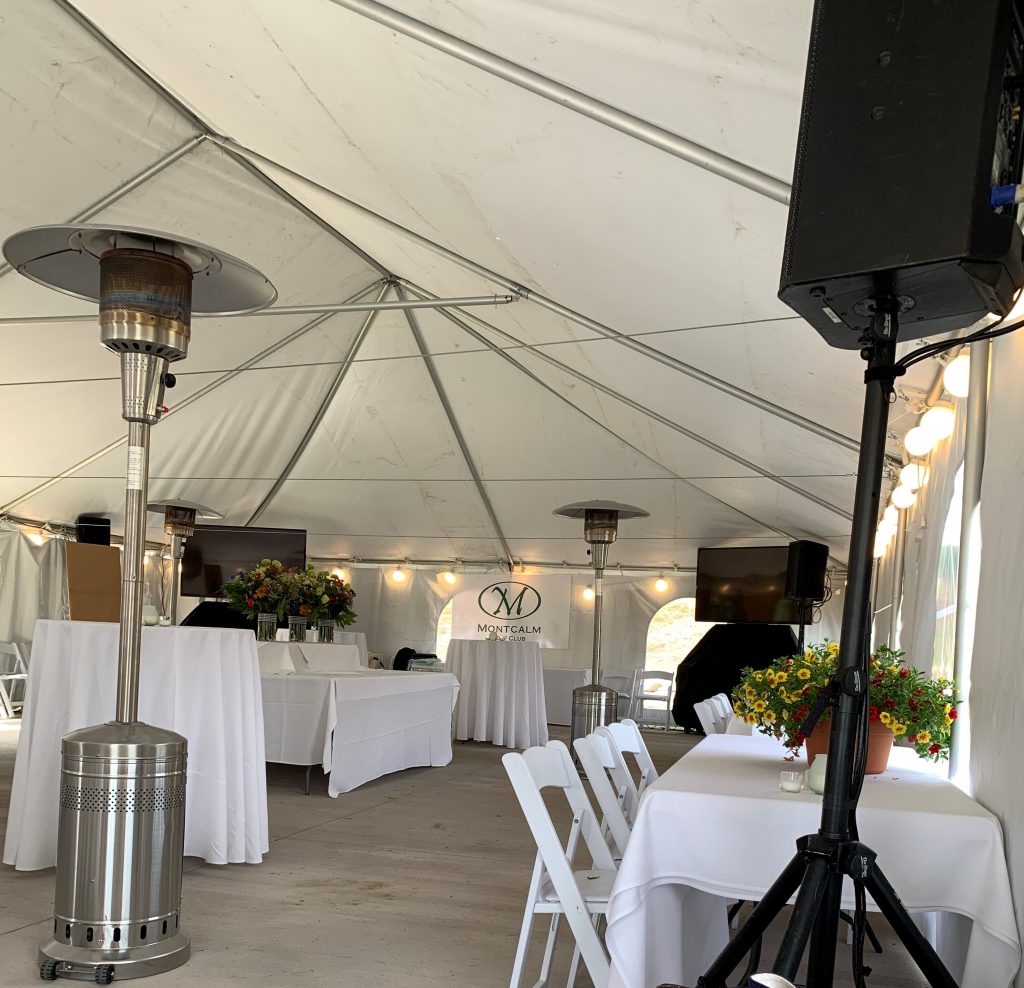This article shares one of the lessons I learned when planning and running a hybrid class reunion event in May 2022. Read the introduction and see the other lessons in this series here.
Lesson
Poor sound is one of the biggest complaints in hybrid meetings. Either the people in the room can’t hear the remote attendees, the remote attendees can’t hear some or all of the people in the room, there is feedback, or all of the above. At the reunion event we were fortunate that we had a full AV setup and AV tech on hand to help. Even with that additional equipment and support we still needed to carefully plan the audio in the tent so that everyone in the tent and on the Zoom call could hear the program. Our planning paid off because we got very positive comments about the audio quality.
We decided to use four speakers in the tent. With a large “room” we wanted people in all parts of the room to be able to hear clearly without having the volume too loud at the front of the room just so the people at the back could hear. We had the luxury of two wireless handheld mics that each of the presenters used when speaking. This made it much easier to hear what was being said. We paid attention to the placement of the speakers in the room and where the presenters were going to be standing. This is important to reduce the chance of having feedback.
In the photo below taken from the back of the tent you can see three of the speakers: one at the back closest to the camera and two to the outside the two 70-inch TVs at the front of the room. Spreading out the speakers and leaving ample room in the middle of the front of the room for the presenters was key in reducing feedback.

Let me do a short detour into the topic of feedback since it is one of the biggest issues in hybrid meeting rooms, especially for those who don’t understand how it is created. Feedback in an audio system is that high screeching sound you hear sometimes that makes everyone cringe. Feedback gets created when the output from a speaker gets heard by a microphone in the same audio system. The sound output is fed back into the system input, hence the term feedback.
There are two key steps in reducing the chance of feedback. First, move any audio inputs, such as microphones, away from audio outputs, such as speakers. This is easier if the microphones are set to just capture a narrow area close to the mic. It reduces the chance of speaker output also being picked up and is why many handheld mics are set this way by default. In the setup we had in the tent we made sure that the presenters would not be close to the speakers and that they were standing parallel to the speakers so the mics would not pick up the speaker output. This is harder with laptop or webcam mics since they are designed to have a much wider zone to try to pick up the voice of the person in the room.
Second, make sure there is only one audio system in the room. When using professional AV this is simple since there is only one system in the room. With hybrid meetings this becomes a significant challenge. Each laptop or device that is connected to the meeting in the room is essentially an audio system since it has an input, the laptop mic, and an output, the laptop speakers. It is much easier for the output on one person’s laptop to be fed into the mic on the laptop beside them. Since all inputs and outputs are connected to the same audio system in the meeting platform, feedback is much more likely to occur.
You may be wondering why you don’t always get feedback in every virtual meeting since your laptop mic and speakers are close to each other. The meeting platforms know what sound is coming from each mic and it doesn’t feed your own voice back to your speakers. The meeting platforms assume each pair of mic and speakers is in its own room. When you put multiple laptops in the same room it can’t separate the audio inputs and outputs which is why room audio issues can occur.
If you have a meeting room that has a professional AV setup, you may think you don’t need to worry about all this. Incorrect. Unless that room audio system was designed specifically for virtual and hybrid meetings, it assumes that it is the only audio system in the room. Bringing in laptops that are feeding the room audio back into the room will cause feedback because the system was not designed to compensate for that situation.
Hybrid meetings introduce audio scenarios that existing meeting rooms were not designed to handle. That’s why as a meeting organizer you need to determine the best approach to have great audio quality in each hybrid meeting. It is also why upgrading meeting rooms to handle hybrid meetings can be so expensive.
Applying this lesson to your meetings
Mute all devices except one in the room
It is crucial to only have one audio system in the room. Make sure everyone mutes both the mic and speaker on their laptop in the room. The mic can be muted in the meeting platform but the speakers need to be muted in the operating system. This will need to be an instruction you give each attendee in the room every time. There will be one system unmuted in the room which will be the one you control as the meeting organizer.
Consider a Bluetooth speaker & multi-mic audio device for your laptop
If you are using your laptop as the audio system, consider using a Bluetooth speaker that has multiple microphones. I suggest the PowerConf S3 Bluetooth Speakerphone that has six mics to pick up in all directions, background noise reduction, is optimized for voices and is battery powered. Connect it via Bluetooth to your laptop and use this device as the mic and speakers in the meeting platform. This gives you a much better audio system than your laptop mic and speakers that only face in one direction. Watch the video below to hear how it improves audio quality over a laptop mic. (Here’s a list of other hybrid meeting room equipment I recommend)
Consider using a phone for the audio
Many meeting rooms already have a speakerphone and mic system installed. You can use this existing audio system in a hybrid meeting. Use the call-in phone number for the meeting to connect the phone system to the meeting as a separate attendee. Mute all other devices in the room. This phone system has multi-directional mics and a speaker system so it will improve the audio quality for those in the room and those attending virtually. As an alternative in a small meeting room you can consider using the speakerphone feature of your smartphone. Use it to call into the meeting then place it on the table so everyone can hear it and the mic picks up the people sitting around the table. This can work for a few people but would not likely work with more than four people in a small room. The phone system is a separate attendee in the meeting that you will see in the attendee panel and be able to control from there if needed.
Wrapup
Audio quality can be one of the trickiest aspects of a hybrid meeting. By understanding how feedback is created you can make decisions about what equipment you should consider and how to use mics and speakers.

Dave Paradi has over twenty-two years of experience delivering customized training workshops to help business professionals improve their presentations. He has written ten books and over 600 articles on the topic of effective presentations and his ideas have appeared in publications around the world. His focus is on helping corporate professionals visually communicate the messages in their data so they don’t overwhelm and confuse executives. Dave is one of fewer than ten people in North America recognized by Microsoft with the Most Valuable Professional Award for his contributions to the Excel, PowerPoint, and Teams communities. His articles and videos on virtual presenting have been viewed over 4.8 million times and liked over 17,000 times on YouTube.
